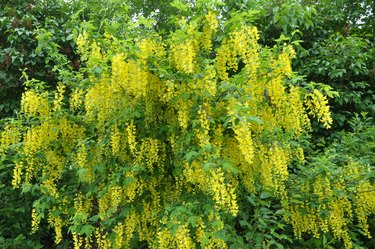
Caragana (Caragana spp., USDA plant hardiness zones 2-7) is a genus within the Leguminosae and Fabaceae family that belongs to the major angiosperms (flowering plants) group. There are approximately 80 to 100 species, including the well-known Walker Siberian peashrub (Caragana arborescens 'Walker,' zones 2-8). It also has a few other names, including weeping Walker caragana, Walker weeping caragana and Siberian pea tree. It is known to be invasive in certain regions, and you should prune it to keep it under control as well as healthy and shaped.
About Siberian Peashrub
Video of the Day
Native to northern China and eastern Russia, Siberian peashrub is a deciduous shrub that is often used as a border, screen, windbreak or hedge. It grows to 15 to 20 feet high and 12 to 15 feet wide, prefers full sun and can tolerate droughtlike conditions. This shrub can get to be quite large and has bright green, 3-inch-long fernlike leaves that grow in pairs. It produces yellow flowers resembling small peas; these grow singly and sometimes in clusters during May.
Video of the Day
The flowers have long stalks and are bundled into leaf axils inside branchlets. The peas are only about 3/4 inch long, usually turning upward with sides that may be curled back. The calyx surrounding the base is tubular, approximately 1/3 of the length of the flower and hairy/silky. These flowers smell nice but are not overpowering.
Small thorns form at the nodes, which are often hard to see. The flowers develop on the previous year's wood, and once the flowers are spent, they develop into yellowish-green pods that turn brown in the summertime. These are pea pods; they usually pop open to reveal what's inside. These trees and shrubs do well almost anywhere, including full sun, partial shade and moist or dry soil. Plant them in sandy, clay or loamy soils with high alkalinity or acidity; they aren't picky.
Pruning Weeping Caragana
These low-maintenance shrubs are easy to care for and don't require a lot of watering. You should prune them regularly to promote air circulation, remove damaged and dead branches and keep an attractive shape. Prune them in late winter to early spring for the best results and wear gloves to protect your hands from the thorns.
If your weeping caragana blooms in the spring, you will want to prune it once the flowers are spent so that it thrives in the following years. To do this pruning, you need to cut at the base of the shrub to take off 1/3 of the oldest branches. At the same time, you must cut off the old canes as close to the ground as you can; new shoots will grow from the base. If the shrub is severely overgrown, it's a good idea to prune it in the very early spring before you start seeing signs of growth.
Pruning Caragana in Winter
While caragana can be an attractive plant for your yard, these hardy shrubs are not fast growers, so you shouldn't need to prune yours that often. To control growth, you'll want to be sure to prune the caragana while it is still young. This early pruning time promotes branching and can encourage bushier growth. In general, this pruning is best done in the wintertime, typically between October and March in the United States.
A winter pruning can also rejuvenate your caragana, and you should do this pruning only a little bit at a time; spreading it out over a three-year period can help your plant grow better. You'll want to saw or cut away a third of the branches down to about 1.64 feet. When you do this, you should make sure to prune all of the branches rather than just the outermost ones. You can cut these back to one outward growing bud.